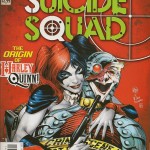 In order to do due diligence for this review of Suicide Squad #7, “The Origin Of Harley Quinn”, I was going to re-read 1994’s The Batman Adventures: Mad Love by Paul Dini and Bruce Timm. Dini, after all, created Harley Quinn and, frankly, my first reaction after reading the conclusion to Adam Glass’s reboot of her character was that I wanted to read the original. However, Mad Love doesn’t appear to be on any of our book shelves at the moment – which means it’s in any one of 23 separate, unlabeled long boxes that are stashed in the closet of the Home Office’s second bedroom, and I just don’t have the patience to go digging.
In order to do due diligence for this review of Suicide Squad #7, “The Origin Of Harley Quinn”, I was going to re-read 1994’s The Batman Adventures: Mad Love by Paul Dini and Bruce Timm. Dini, after all, created Harley Quinn and, frankly, my first reaction after reading the conclusion to Adam Glass’s reboot of her character was that I wanted to read the original. However, Mad Love doesn’t appear to be on any of our book shelves at the moment – which means it’s in any one of 23 separate, unlabeled long boxes that are stashed in the closet of the Home Office’s second bedroom, and I just don’t have the patience to go digging.
You know what is out and easily accessible on the book shelves of Home Office Command Central? Batman: Son Of The Demon…just in case Rob wants to get into a drunken pissing contest with a 12 year-old who has a theory that Batman is gay and that Damien was grown in a petri dish in the Bat Cave.
Stranger things have happened. Both here and in the Bat Cave. But, I digress…
The thing is, this issue, and most of the Suicide Squad run in general, isn’t bad. Some of it is pretty good – but it’s not as good as what Dini and company first came up with, even if it’s trying for darker, edgier, clown car…ier, whatever. Perhaps that just my own failing that I can’t get past that.
Or is it? Spoilers and whatnot after the jump.
A few issues back in Suicide Squad, Harley, after finding out that The Joker was rumored to be dead and that his face was hanging up like a trophy over at Gotham PD, managed to slip her nanobot leash and went AWOL from the team. Floyd Lawton, aka Deadshot and also a team member of the squad, was tasked to track her down and “make an example of her”. In issue #7, he and the rest of the team have caught up with her at the police station. The story, as it did in issue #6, switches between the hunt for Harley and flashbacks to her previous life as The Joker’s psychiatrist at Arkham Asylum. Glass’s take is a bit more Clarice/Hannibal Lecter than Dini’s. This isn’t necessarily a bad thing. However, as much as I bitch about some stories being too decompressed, this is one instance where I wish a writer would have slowed down and taken the time to really flesh out a story with that kind of angle. Pieces parts, as flashbacks over two issues, is not enough time to do that story justice. There are some glimpses as to how The Joker won Harley over, but not enough into how he got into her head – and that’s key, really. Given the degree to which Harley, canonically, imprints on and obsesses over The Joker, a few stolen moments and a creepy love token (read issue 6. I’m not going to get into it in detail.) with the catalyst of a shitty boss (issue 7), aren’t quite enough for me to buy into her fixation. I supposed I can fill the story gaps in with my imagination to explain it, but I’d rather Glass just wrote a deeper story. Maybe The Powers That Be at DC just wanted Glass to speed things along so Suicide Squad would be ready for its upcoming crossover with Resurrection Man at the same issue number, which is a shame.
That doesn’t mean there aren’t a couple choice moments in this particular issue that make for an entertaining read. They are highlighted by some fine pencil work by Clayton Henry and Ig Guara, who are in as guest artists. One scene that stands out, and again SPOILERS people, is Harley in the minutes after The Joker drops her in a vat of acid for “her birthday”, because that’s how he was born you know! I’d be inclined to write this scene off as too easy. Wouldn’t The Joker have some other, more creative way to capitalize on Harley’s evident post traumatic shock from events leading up to this scene? But then, Henry and Guara pencil this:
It’s the skeletal remains that are scattered on the floor of the vat that intrigue me. Has The Joker done this before with other women? That interests me.
Also, this book is worth reading, if only for the scenes between Harley and Floyd, recently her occasional lover, at the end. Harley tracks down The Joker’s face. So, what does she do with it?
Floyd and Harley resolve their relationship and her need for closure with The Joker over the course of 24 panels at the end of issue 7. Here, Glass takes his time and builds tension and subtle moments the Joker/Harley story lacked. It’s at turns creepy, gruesome, and heartbreaking – not just for Harley, but for what this story could have been if it could have had the time to have been told properly.


 Podcast RSS Feed
Podcast RSS Feed iTunes
iTunes Google Play
Google Play Stitcher
Stitcher TuneIn Radio
TuneIn Radio Android
Android Miro Media Player
Miro Media Player Comics Podcast Network
Comics Podcast Network